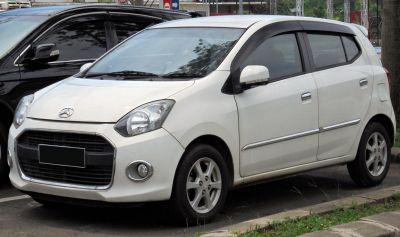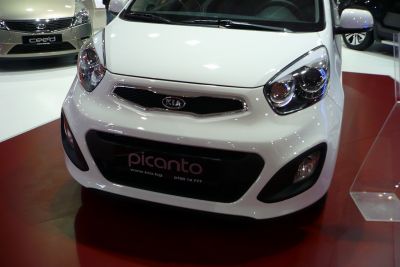 2020 Toyota Wigo (facelift 2020) Dimensions, Size & Specs
2020 Toyota Wigo (facelift 2020) Dimensions, Size & SpecsMeasurements of the 2020 Toyota Wigo, engineered for optimal performance and comfort
| Dimensions | |
|---|---|
| Length: | 3600 mm141.7 in11.8 ft |
| Width: | 1620 mm63.8 in5.3 ft |
| Height: | 1520 mm59.8 in5.0 ft |
| Ground Clearance: | 180 mm7.1 in0.6 ft |
| Weight Specifications | |
| Curb Weight: | 795 kg1753 lbs |
| Maximal permitted Weight: | 1100 kg2425 lbs |
| Tire Specifications | |
| Rims Size: |
|
| Tire Size: |
|
The Toyota Wigo 2020 facelift is a compact hatchback designed to excel in urban environments with its efficient use of space and practical dimensions. Measuring 3600 mm (141.7 inches) in length, 1620 mm (63.8 inches) in width, and standing 1520 mm (59.8 inches) tall, this model offers a balanced footprint that is easy to maneuver in city traffic and park in tight spaces. Weighing 795 kg (1,753 lbs) curb weight and capable of carrying up to a maximum of 1100 kg (2,425 lbs), the Wigo ensures nimble performance while maintaining durability and structural integrity. Notably, the 2020 facelifted Wigo features a ride height or ground clearance of 180 mm (7.1 inches), providing better capability to handle uneven terrain and city road obstacles compared to many other hatchbacks in its class. The vehicle rides on 14-inch rims fitted with 175/65 R14 tires, striking a good balance between ride comfort and efficient handling. Since its production start in 2020 and continuing to the present, the Wigo facelift has maintained its reputation as a practical and budget-friendly hatchback option, especially suited for drivers seeking a small yet versatile car with modern styling and reliable build quality. Overall, the Toyota Wigo 2020 facelift compact hatchback is an ideal choice for those prioritizing ease of driving, efficient space utilization, and fuel economy in busy urban settings.
Discover the standout features that make the 2020 Toyota Wigo a leader in its class
Have a question? Please check our knowledgebase first.
The Toyota Wigo (facelift 2020) measures 3600 mm (141.7 inches) in length, 1620 mm (63.8 inches) in width, and 1520 mm (59.8 inches) in height. These compact dimensions make the Wigo highly maneuverable in urban environments, allowing easy navigation through narrow streets and tight parking spaces. Its relatively small footprint is ideal for city driving, helping drivers to effortlessly handle dense traffic and cramped areas.
With a width of 1620 mm (63.8 inches), the Toyota Wigo (facelift 2020) is slightly narrower than some of its competitors which often measure around 1650-1700 mm (65-67 inches). This narrower width contributes to easier parking in tight spots and better agility on crowded city streets, though it may offer slightly less shoulder room for passengers compared to wider hatchbacks.
The Toyota Wigo (facelift 2020) has a ride height or ground clearance of 180 mm (7.1 inches). This clearance is fairly generous for a compact hatchback, providing enough space to comfortably clear potholes, speed bumps, and uneven road surfaces commonly encountered in urban and suburban settings. A higher ground clearance also enhances the vehicle’s adaptability to rougher road conditions without compromising stability.
Yes, the Toyota Wigo (facelift 2020) fits comfortably into a standard residential garage. Given its length of 3600 mm (141.7 inches), width of 1620 mm (63.8 inches), and height of 1520 mm (59.8 inches), it is smaller than the typical parking space size of around 6 meters by 3 meters. This means the Wigo can be parked and maneuvered within most home garages with room to spare for opening doors and storage.
The Toyota Wigo (facelift 2020) has a curb weight of approximately 795 kg (1754 lbs), which is relatively light for a modern hatchback. This lighter weight positively influences both the car’s fuel efficiency and acceleration performance. A lighter car requires less energy to move, resulting in better fuel economy, especially in stop-and-go urban traffic. Additionally, the reduced weight helps improve agility and handling, making the Wigo easy and responsive to drive.
The Toyota Wigo (facelift 2020) comes equipped with 14-inch rims paired with 175/65 R14 tires. These tire dimensions strike a balance between comfort and agility. The 175 mm tire width provides adequate grip and stability, while the 65 aspect ratio (sidewall height as a percentage of tire width) helps absorb road imperfections, contributing to a smoother ride. The 14-inch rim size is typical for compact cars, offering cost-effective replacement and decent ride comfort.
Compared to the pre-facelift Toyota Wigo, the facelift 2020 model maintains similar compact dimensions, with negligible changes in length, width, and height, focusing more on design refreshes and feature upgrades than size alterations. The core dimensions remain city-friendly, preserving the Wigo's reputation as an agile and efficient commuter car. While the exterior styling was modernized, the unchanged size ensures that benefits like easy parking and maneuverability are retained.
The Toyota Wigo (facelift 2020) is competitive in size within the small hatchback segment. For example, the Kia Picanto measures around 3595 mm (141.5 inches) in length, and the Hyundai i10 around 3670 mm (144.5 inches). With the Wigo’s length at 3600 mm (141.7 inches), it slots comfortably between its rivals. Its width at 1620 mm (63.8 inches) is also comparable, though sometimes slightly narrower. Overall, the Wigo offers similar compact dimensions that balance urban practicality with interior usability.
The maximum weight capacity for the Toyota Wigo (facelift 2020) stands at 1100 kg (2425 lbs). This includes the curb weight and payload such as passengers, cargo, and additional equipment. Given its curb weight of 795 kg (1754 lbs), the Wigo can carry up to around 305 kg (672 lbs) of additional load safely. This capacity is typical for compact hatchbacks and allows comfortable transportation of four to five occupants with moderate cargo without compromising safety or performance.
The Toyota Wigo facelift 2020 brought styling enhancements such as refreshed front and rear bumpers, updated grille designs, and new lighting elements that gave the hatchback a more modern, dynamic look. On the feature front, some markets saw improvements to the infotainment system, enhanced safety features, and interior trim updates. These changes aimed at keeping the Wigo competitive in the entry-level hatchback segment while maintaining its core values of affordability, reliability, and practicality.
Discover similar sized cars.

| Production: | 2012-2017 |
|---|---|
| Model Year: | 2013 |
| Length: | 3600 mm141.7 in |
| Width: | 1600 mm63.0 in |
| Height: | 1520 mm59.8 in |

| Production: | 2023-present |
|---|---|
| Model Year: | 2024 |
| Length: | 3595-3605 mm141.5-141.9 in |
| Width: | 1595 mm62.8 in |
| Height: | 1485-1495 mm58.5-58.9 in |

| Production: | 2020-2023 |
|---|---|
| Model Year: | 2021 |
| Length: | 3595 mm141.5 in |
| Width: | 1880 mm74.0 in |
| Height: | 1485 mm58.5 in |

| Production: | 2017-2020 |
|---|---|
| Model Year: | 2017 |
| Length: | 3595 mm141.5 in |
| Width: | 1880 mm74.0 in |
| Height: | 1485 mm58.5 in |

| Production: | 2015-2017 |
|---|---|
| Model Year: | 2015 |
| Length: | 3595 mm141.5 in |
| Width: | 1880 mm74.0 in |
| Height: | 1480 mm58.3 in |

| Production: | 2015-2017 |
|---|---|
| Model Year: | 2015 |
| Length: | 3595 mm141.5 in |
| Width: | 1880 mm74.0 in |
| Height: | 1480 mm58.3 in |

| Production: | 2011-2015 |
|---|---|
| Model Year: | 2011 |
| Length: | 3595 mm141.5 in |
| Width: | 1595 mm62.8 in |
| Height: | 1480 mm58.3 in |

| Production: | 2011-2015 |
|---|---|
| Model Year: | 2011 |
| Length: | 3595 mm141.5 in |
| Width: | 1595 mm62.8 in |
| Height: | 1480 mm58.3 in |
